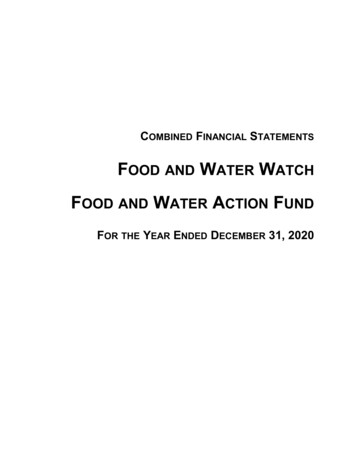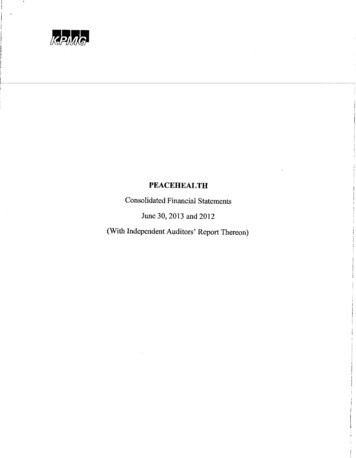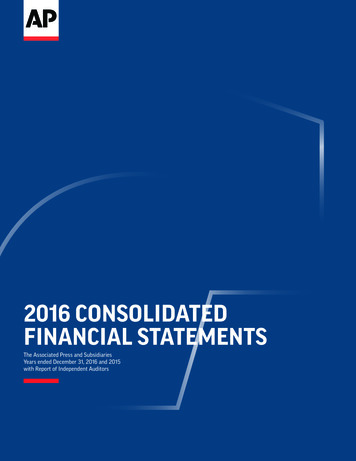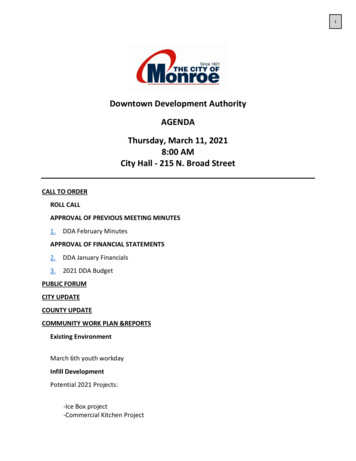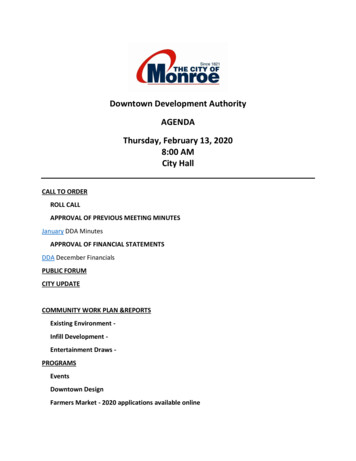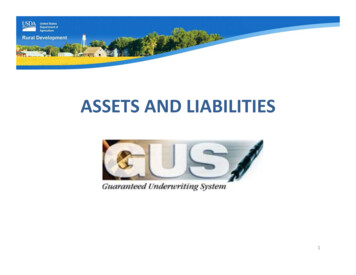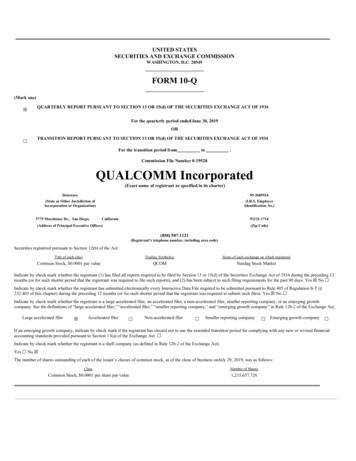
Transcription
The UK’s liabilitiesto the financialmechanisms of theEuropean UnionBy Bob LyddonLyddon Consulting Services Limited
The UK’s liabilities to thefinancial mechanisms ofthe European UnionBy Bob LyddonLyddon Consulting Services LimitedISBN: 978-0-9564614-6-9Published in May 2016 byThe Bruges Group, 214 Linen Hall, 162-168 Regent Street, London W1B 5TBwww.brugesgroup.comFollow us on twitter@brugesgroup Find our facebook group:The Bruges GroupBruges Group publications are not intended to represent a corporate view of European andinternational developments. Contributions are chosen on the basis of their intellectual rigourand their ability to open up new avenues for debate.
Table of ContentsPreface. 4Author biography. 5Source Documents. 6Glossary. 7Executive Summary.11Sovereign risk and “the full faith and credit of the United Kingdom”.15EU Member State credit ratings and the “creditor ladder”.16How obligations to EU organisations sit within the structure of the UK’s public finances.19What status the UK’s public finances are in and how calls for funds from the EU are met.21The organisations that benefit from Member State guarantees andhow the guarantees could materialise into a demand for cash.22The European Union (including the European Financial Stabilisation Mechanism).23The European Investment Bank (including the European Fund for Strategic Investments).35The European Central Bank.59Who is benefitting from all of this?.65The European Union and the European Investment Bank as “credit enhancements”for investor money going into borrower countries.66Which Member States are contributing the most in terms of their percentage sharein the guarantee structure?.67Which Member States are benefitting the most in terms of the quantity of loans they are accessing?.68Which Member States are benefitting the most from the “credit enhancement”being applied by the European Union and the European Investment Bank.72Which Member States are being exploited the most by lending their “full faith and credit” asa “credit enhancement” for loans from investors to both Member States and non-Member States.77Absence of UK sovereign controls.78Critique of this “washing machine” in a time when the UK has imposed austerity on itself.79Summary and conclusions.79AppendicesThe credit-rating systems of Standard and Poors (S&P) and Moodys and their importance.81EU Member State Long-Term Credit Ratings and the status of Member States’ linkage to the Euro.85
PrefaceThis paper has been commissioned by the Bruges Group in the run-up to the June 2016 referendum on the UK’scontinued membership of the European Union.The Bruges Group believes understanding the economic consequences of that decision requires a full pictureto be obtained, addressing all of (i) the trade benefits and drawbacks to EU membership, (ii) the cash costs andcash benefits, and lastly (iii) the financial obligations that are part and parcel of EU membership as well as anybenefits that go with those obligations.This paper is about the last one of these, while touching on the second one in order to put it in context.It lays out how the mechanisms operate under which the UK’s financial obligations towards the EU are set, andhow the obligations can be increased or reduced.It describes the risk-sharing amongst Member States, on a sliding scale between three variations:1.Lowest sharing: the risk is shared by Eurozone members only, and no member’s obligation can exceeda fixed proportion of the whole amount;2.Middle sharing: the risk is shared by all Member States, but still no member’s obligation can exceed afixed proportion of the whole amount;3.Highest sharing: the risk is shared by all Member States on a basis where each Member State could beasked to pay more, up to the entire amount, if other Member States cannot pay.Any Member State, particularly a Euro-Out one, should be sensitive to these distinctions, as the credit ratingagencies and international investors are. Variation (3) represents the best credit risk for investors as it is the onein which obligations are “collectivised” to the highest possible degree; by extension it is the worst one for Member States.The European authorities have tried and will continue to try to bring Variation (3) into play in as many instancesas possible, both directly through mechanisms like the European Financial Stabilisation Mechanism, but alsoindirectly, such as in the case of the European Fund for Strategic Investments, under which the EIB - operating toVariation (2) itself - benefits from a guarantee from the European Union, which operates to Variation (3).The reader will make up their own mind after examining this paper whether it is truly the case that the UK is notpart of the Eurozone bailout when most of the mechanisms used to facilitate the Eurozone recovery operateunder Variations (2) and (3), in which all Member States are involved: The European Union – rated AAA/Aaa European Financial Stabilisation Mechanism – through the EU European Investment Bank – rated AAA/Aaa European Fund for Strategic Investments – through the EU and EIBThe three mechanisms in which the UK does not participate are: European Financial Stability Facility – rated AA/Aa1 European Stability Mechanism – rated Aa1 (Moodys only; no S&P rating) The informal TARGET imbalances within the European System of Central Banks4
Author biographyBob Lyddon is an expert in international banking, working through his own consultancy company Lyddon Consulting Services.Bob’s particular areas of expertise include banking regulation, the sovereign debt crisis, and international money transfer and electronic banking.Bob has consulted for major organizations on the Single Euro Payments Area and Payment Services Directive 1,and in 2012 he wrote, for The Bruges Group, an authoritative paper on the UK’s financial liabilities at that time tothe European Investment Bank, the European Central Bank and Eurosystem, and the European Community. Thatpaper – “The UK’s risks and exposure to the European Investment Bank and other European financial mechanisms: amounts, safeguards and breaches in the dyke” – contributed to the UK Treasury including the UK’scontingent liability on the European Investment Bank in the national accounts for the first time.Between 1997 and 2000, Bob was a Principal in the Strategic Change Management Consulting practice ofPricewaterhouseCoopers, and managed several projects for the original implementation of the EUR, notably inLuxembourg and London.In a banking career over 17 years Bob was latterly Director of European Cash Management at BankBoston,where he designed of the Connector multibank payments network and the Optimizer cross-currency notionalpooling service. Bob served initially with Lloyds Bank International, where he was involved with Sovereign Risklending under the Dutch government export credit schemes, financing such projects as dry docks in Nigeriaconstructed by the Royal Dutch Harbourworks company, and gas-fired boilers supplied by Stork Ketels for power stations in Taiwan.Bob obtained a First Class B.A. degree in Modern Languages at Fitzwilliam College Cambridge in 1980, andspeaks French, German, Norwegian and Dutch. He had periods of study at the universities of Bergen andFreiburg-im-Breisgau, and lived in Antwerp, Zurich and Amsterdam while working for Lloyds Bank International.5
Source DocumentsTreaty on the Functioning of the European Union – Consolidated Version published in the Official Journal ofthe European Union on 26.10.12Moodys credit rating report on the European Union 30.09.15European Union Financial Report 2014Council Regulation (EU) No 407/2010 establishing the EFSM – the European Financial Stabilisation MechanismCouncil Implementing Decisions on the granting of financial assistance to Ireland and Portugal (various over2010 to 2013)European Investment Bank Annual Reports 2011-2014Moodys credit rating report on the European Investment Bank 09.07.15Decision No 1080/2011/EU of the European Parliament of the Council of 25 October 2011 granting an EUguarantee to the European Investment Bank against losses under loans and loan guarantees for projectsDecision No 466/2014/EU of the European Parliament of the Council of 16 April 2014 granting an EUguarantee to the European Investment Bank against losses under financing operations supporting investmentAn investment plan for Europe 26.11.14 COM(2014) 903 FinalRegulation (EU) 2015/1017 of the European Parliament of the Council of 25.06.15, establishing the EuropeanFund for Strategic InvestmentsEFSI Project Factsheets for operations up to 22.01.16European Central Bank Annual Report 2014European Financial Stability Facility (“EFSF”) website - www.efsf.europa.euEuropean Stability Mechanism (“ESM”) website - www.esm.europe.eu6
GlossaryTermMeaningBasel Bank CapitalAdequacySuccessive sets of requirements issued by the Bank for International Settlementsbased in Basel, defining how much capital a bank should hold to cushion itselfagainst losses. The requirements cause a bank to identify a quantum of riskagainst which it should hold – under the current Basel III rules – 8-10% in capital.The quantum is arrived at by identifying the nominal amount of each piece ofbusiness that involves a risk of loss, and adjusting it for the creditworthiness ofthe counterparty and the risk in the piece of business itself. Then all the adjustednominal amounts are totalled and multiplied by 8-10%, to arrive at the bank’srequired level of capital.Forms of money that are regarded as free of credit risk by the central bank of aparticular country, being money that represents the sovereign risk of that country. Inthe UK the forms would be:Central bank moneyA credit balance on an account at the Bank of England (which can only be in GBP)GBP note and coin issued by the Bank of EnglandUK government bonds - giltsCredit enhancementCreditor ladderCredit ratingCredit rating agencyCross-guaranteeThe different forms of central bank money must be ‘fully fungible’: instantlyexchangeable for one of the other forms at par/without a ‘haircut’Generic term for any form of security, guarantee, insurance policy or third-partyundertaking that reduces the credit risk taken by a lender when advancing funds to aborrower, and which makes full repayment of capital and interest, and on time, morelikely.The seniority level of a creditor’s claims in a bankruptcy. The trustee of thebankruptcy will pay out the proceeds of the liquidation of the assets in order ofcreditors’ seniority. The first level will be paid out in full before the next level receivesanything. Shareholders are at the bottom of the ladder. The amount that a certainlevel of creditors gets paid out as a percentage of their claims is known as “pence-inthe-pound”. The maturity date of a creditor’s claim has no impact on its seniority in abankruptcy: secured long-term claims will outrank unsecured short-term claims.An estimate of the ability of a person or organization to fulfil their financialcommitments in full and on time, based on previous dealingsA credit rating agency (CRA, also called a ratings service) is a company that assignscredit ratings, which rate a debtor’s ability to pay back debt by making timely capitaland interest payments and the likelihood of default. Standard and Poor and Moodysare the two best known CRAsNormally used in commercial banking in the context of notional pooling: subsidiarycompanies in the same group are asked to guarantee one another’s overdrafts inthe pool in order that the bank can classify them as owed by a ‘single counterparty’.This partially negates their status as separate limited-liability companies. Banks willgenerally not offer pooling unless they have either cross-guarantees or a declarationof joint-and-several liability, and would also request to have positive and recent legalopinions as to the validity and enforceability of every cross-guarantee against theissuing subsidiary. That could run to a number of legal opinions if the subsidiaries areregistered in different countries, even if the pooling agreement and the guaranteesare all subject to a single governing law and a single exclusive forum of jurisdiction7
TermMeaningEU Fiscal StabilityTreaty or “EFST”The Treaty on Stability, Co-ordination and Governance in the EMU, aka the FiscalStability Treaty, signed amongst the EU Member States that are part of the SingleCurrency – the EUR – to agree to reduce the ratio of government debt to GDP to 60%by 2030, and to make such adjustments as are needed to spending to take accountof additional age-related social costs that may arise up to 2050 i.e. to adjust welfarespending downwards before 2030 so that the 60% ratio can be sustained up until2050The first Eurozone bailout mechanism, agreed in May 2010 and involving all EUMember States. The ceiling is 60 billion; 46.8 billion is currently lent to Ireland andPortugal. 13.2 billion is available.The second Eurozone bailout mechanism, also agreed in 2010 but involving only theEurozone members. It has loans out under three programmes, all fully drawn: Ireland 17.7 billion; Portugal 26.0 billion; Greece 143.6 billion; total 187.3 billion. It isa Luxembourg-incorporated special purpose company. Its capital is in the form ofpart-paid shares owned by the Eurozone countries, with the subscribed-but-uncalledcapital callable on a several-but-not-joint basis. No new programmes can draw onthe EFSF, and no existing borrowers can draw more. The ESM administers the EFSF,meaning receiving capital and repayments on its loans, paying out on the bondsissued to finance the loans, and calling the capital when neededThe third Eurozone bailout mechanism, also agreed in 2010 and again involving onlythe Eurozone members. It has a maximum lending capacity of 500 billion, of which 450 billion is currently available. It is a Luxembourg-incorporated special purposecompany. Its capital is in the form of part-paid shares owned by the Eurozonecountries, with the subscribed-but-uncalled capital callable on a several-but-notjoint basis. New programmes can access the ESM and the EFSM, but not the EFSF.The European System of Central Banks (ESCB) is composed of the European CentralBank (ECB) and the national central banks (NCBs) of all 28 EU Member States. TheESCB is responsible by EU Treaty for issuance of Euro note & coin and for carryingsuch operations as are needed for the proper functioning of the Euro within thescope of the Treaty mandate and the ECB/NCBs’ own statutes and powersThe European Exchange Rate Mechanism, a system introduced by the EuropeanCommunity in March 1979, as part of the European Monetary System (EMS). Its goalwas to reduce exchange rate variability and achieve monetary stability in Europe,in preparation for Economic and Monetary Union and the introduction of a singlecurrency, the euro, which took place on 1 January 1999. After the adoption of theeuro, it mutated into ERM II, a policy charged with linking currencies of EU MemberStates outside the Eurozone to the euro, having the common currency as a centralpoint. The goal was to improve the stability of those currencies, as well as to gain anevaluation mechanism for potential Eurozone members. The only currency still in theERM is the Danish kroner (DKK) whose central valuation against the EUR is EUR1 DKK7.46038. The last one out was the Lithuanian litas (LTL) when it joined the Euroon 1/1/15 at an irrevocably fixed exchange rate of EUR1 LTL3.4528A share that a shareholder has paid for in one sum and where there is no differencebetween the subscribed amount per share and the paid amount per shareA monetary measure of the value of all final goods and services produced in a period(quarterly or yearly). Nominal GDP estimates are commonly used to determine theeconomic performance of a whole country or region, and to make internationalcomparisons.The sum of value added by all producers who are residents in a nation, plus anyproduct taxes (minus subsidies) not included in output, plus income received fromabroad such as employee compensation and property incomeEuropean FinancialStabilisationMechanism (“EFSM”)European FinancialStability Facility(“EFSF”)www.efsf.europa.euEuropean StabilityMechanism (“ESM”)www.esm.europe.euEuropean Systemof Central Banks(“ESCB”)Exchange RateMechanism or ERMFully-paid shareGross DomesticProductGross NationalIncome8
TermMeaningGroupementFrench corporate construction: Economic Interest Group. A French parent and itsd’intêret économique French subsidiaries sign into a GIE so as to submit a single corporation tax return.(“GIE”)French banks are then able to offer the GIE notional pooling of its bank accountbalancesJoint-and-severalAn arrangement amongst parties to a business transaction, usually under aliabilityguarantee from shareholders in favour of creditors, where the creditors may recoverall of their claim from any of the shareholders regardless of their individual share inthe companyLimited liabilityThe type of corporation or company where the shareholders cannot lose more thanthe capital they have subscribed to, regardless of the size of the company’s debts tothird-parties should the company go into liquidationMultiannual Financial The MFF: the EU long-term spending plan. The multiannual financial framework laysFrameworkdown the maximum annual amounts (‘ceilings’) which the EU may spend in differentpolitical fields (‘headings’) over a period of at least 5 years. The current MFF coversseven years: from 2014 to 2020Notional poolingA banking service whereby the bank balances owned by sister companies in acorporate group can be offered an interest calculation that recognises that the creditbalances owned by some participants match the amounts of the overdraft balancesowed to the bank by others. No or very little interest spread is then charged onthis matched balance. In order to achieve a zero interest spread it is usual for thecustomer to have to present its different subsidiaries as a ‘single counterparty’ bymaking them either cross-guarantee one another’s overdrafts, or sign a statement ofjoint-and-several liability for one another’s overdraftsOECDOrganisation for Economic Cooperation and Development, comprising 34 advancedeconomies and founded in 1961 to stimulate economic progress and world trade.Used under Basel I Capital Adequacy system to distinguish between ‘safe’ and ‘risky’countries.Organschaftsvertrag ‘Corporation agreement with absorption of Profit and Loss’: German corporatemit Gewinn - undconstruction whereby a parent company and a subsidiary sign an agreement for theVerlustabfűhrungparent to ‘take over’ the annual profit/loss. Enables them to submit a consolidatedcorporation tax return, but to avoid consolidation for taxes such as the “Trade activitytax” (“Gewerbeumsatzsteuer”). Used by BMW AG with BMW Leasing GmbH: BMWLeasing GmbH is a static asset-holding company and so is not eligible for “Tradeactivity tax”, whereas BMW AG is. BMW Leasing needs to borrow large amountsto fund the vehicles: banks regard the existence of the “Organschaftsvertrag” as astructural guarantee of BMW Leasing’s debts by BMW AG, and so that is a “creditenhancement” and enables BMW Leasing to borrow the quantity of money it needsand on fine termsPart-paid shareA share that a shareholder pays for in more than one sum. The shareholder iscommitted to pay the entire amount at the point they subscribe to the share.Normally the share only remains part-paid for a short period e.g. 50% of the cashamount has to be paid within two weeks, and the balance a month after that.However, the terms of the share offer will set out the payment schedule, and thereis no barrier in law to the shares being issued on a part-paid basis, with no date setfor the payment of the balance, and/or with no certainty that the balance will not becalled in several amounts or over an extended period. In the books of the companythe subscribed-but-not-called capital has the effect of a guarantee fund acting asa credit enhancement to creditors’ claims. In a liquidation the bankruptcy trusteewould retain the right to call in the balance of the part-paid capital, and to use thatmoney to meet the claims of the creditorsSeveral-but-not-joint An arrangement amongst parties to a business transaction, usually under aliabilityguarantee from shareholders in favour of creditors, where the creditors may onlyrecover from any shareholders the same share of the claim as that shareholder ownsin the business – shareholders are not responsible for one another’s obligations9
TermMeaningShare premiumThe difference between the nominal value of a share and the price paid by aninvestor to subscribe to it. The price is normally set at a premium to the nominalvalue in order to achieve the effect of limiting the shareholder’s liability to pay in,namely to the subscription price. This is exactly so as not to achieve the situation ofa part-paid share: that a shareholder might later be called upon to pay in more so asto satisfy creditors and experience a liability that is higher than the amount they paidfor the shares when subscribingA qualifying criterion for a bank to offset credit balances and overdraft balancesin its accounts as well as for calculating other costs such capital adequacy, depositinsurance and central bank reserves. If a bank is able to offset balances in its ownaccounts, it would be normal not to charge the customer an interest spread betweencredit and overdraft balances, unless not all the other ancillary costs could beeliminated“Sovereign risk” is the credit risk of a government – the best and lowest creditrisk available in the country concerned. It was thought to be synonymous withbeing a type of obligation that was free of credit risk, up until the Latin American‘foreign currency debt’ defaults of the 1980s. After that the definition of “riskfree” was amended from “any debt obligation of a sovereign government” to “anydebt obligation of a sovereign government in its own currency”. Gilts in the UK orTreasuries in the US qualify as that: in other words foreign currency obligations werenot considered as risk-free but domestic currency obligations were. This definitionhas been undermined by the EUR, where several countries use a currency but nonehas the control over the tools for its management commensurate with its obligationsbeing regarded as risk-free. To be genuinely credit risk-free an obligation of agovernment must be in its own currency of which it is the sole user. The existence ofmultiple users of a currency damages the quality of the central bank money in thatcurrency and reduces the quality of the respective government’s Sovereign Risk,which is the fault line at the centre of the Euro.A shareholder enters into a contract to take ownership of a share in exchangefor a consideration, normally cash. The shareholder is committed at the point ofsubscription, and has an enforceable obligation to deliver the cash on the due date.Single counterpartySovereign riskSubscribed share10
Executive SummaryOn 23 June 2016 the UK electorate is to be asked about the UK’s continuing membership of the EuropeanUnion.Money is an aspect of this, and the money question comes in several aspects: Does the UK benefit in terms of trade in goods and services with the EU due to access to markets, andwhat is the price paid if any for that access? What does the UK pay in cash terms for the running of the EU, and what does it get back in cash? What financial liabilities does the UK carry as part of EU membership and what benefits come back inreturn?This paper concentrates on the last question, while touching on the second one in order to put the third one incontext.The first question has been answered by the Office of National o-uk-trade-and-investment-/sty-eu.htmlThe UK’s trade deficit with the EU for 2014 was:CategoryAmount - billionsAmount - EUR billionsGoods(77.0)(96.3)Services 15.4 19.3Total(61.6)(77.0)To the second question, the UK’s cash contribution to the EU in 2014 was:CategorySourceAmount - EUR billionsGNI-based Member Cash ContributionEU 2014 Financial Report(14.5)UK rebateEU 2014 Financial Report 6.1VATEU 2014 Financial Report(2.9)Other EU “Own Resources”EU 2014 Financial Report(2.7)Total cash paid inEU 2014 Financial Report(14.0)EU cash spent in the UKwww.fullfacts.org 4.0Net cash position in 2014(10.0)As regards financial liabilities – the third question – the UK has value-at-risk in several ways.The two easiest ones to demonstrate are the value-at-risk in the capital of the European Investment Bank (EIB)and the European Central Bank (ECB):CategorySubscribedPaid-inCallableEIBEUR39.2 billionEUR3.5 billionEUR35.7 billionECBEUR1.5 billionEUR0.1 billionEUR1.4 billionTotalEUR40.7 billionEUR3.6 billionEUR37.1 billionThe EIB is acting counter-cyclically and aggressively to increase its lending within the EU under its programmeof regular loans and under the European Fund for Strategic Investments, and is aggressively increasing its loansoutside the EU in pursuit of EU political objectives.11
The capital base of the EIB remains small, and so a call for a further injection of capital is likely, both to supportits expansion and to cushion credit losses: the European Fund for Strategic Investments involves the EIB in muchhigher-risk loans than its regular portfolio.The ECB has a very small capital base, and yet its governor, Mario Draghi, claims to be using it as a base fromwhich to direct a bazooka at the Eurozone’s problems.A call on the UK from the ECB for extra capital can be considered a wild card.In neither case can a call for ‘extraordinary support’ - above and beyond the UK’s contractual liabilities - be ruledout.At least the liabilities of the UK towards the EIB and the ECB are on a several-but-not-joint basis i.e. the UK is notcontractually obliged to pay the claims made on other Member States as well as our own, if these other Member States are in financial difficulty.The contractual liability towards the European Union is the more worrying because it is on a joint-and-severalbasis, because the liability is for the entire EU Budget, and because the figures are very large and run for multiple years: The cash budget for the remainder of the current budget period (called a Multiannual Financial Frameworks or MFF), which has been set until 2020; Funds, facilities and guarantees already engaged during previous MFFs; What can be added as funds, facilities and guarantees during the current MFF.The key link is the EU Budget, which is not allowed to go into deficit. Member States are responsible for the EUBudget and their contributions are set so that the EU Budget shows a surplus. This acts as a structural guaranteeof the European Union’s liabilities by the Member States, including by the UK, to any creditors of the EuropeanUnion.The cash budget is met from: VAT – which by treaty counts as the EU’s “Own Resources” Customs/Sugar levies, which by treaty also count as the EU’s “Own Resources” The Member State cash contribution based on each Member State’s GNI as a share of EU GNIThe Member States have committed to fund the EU Budget, on a joint-and-several basis, for the remainder ofthe current MFF. The committed amount is 1.23% of EU GNI, of w
Basel Bank Capital Adequacy Successive sets of requirements issued by the Bank for International Settlements based in Basel, defining how much capital a bank should hold to cushion itself against losses. The requirements cause a bank to identify a quantum of risk against which it should hold - under the current Basel III rules - 8-10% in .


